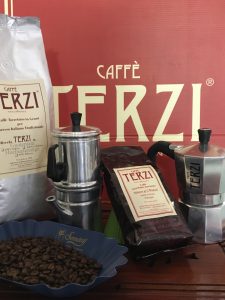
Unlike the Moka, Napoletana coffee pot uses, in addition to heat, the force of gravity.
Apparently the first copper “prototype” was made in France in 1819 by Morize, a French man of Ottoman origin. With its cylindrical shape, Napoletana consists of a tank, a cylindrical filter with its lid to be tightened and a Coffee pot to collect the drink.
Soon the copper turned to aluminium for mass production and so Napoletana spread throughout Italy, resisting until 1933 when the most modern Moka of Alfonso Bialetti appeared.
The preparation takes place as follows: the water tank is filled up to a tiny hole on the coffee pot, which indicates (by the spillage of small water bubbles) the achievement of the boiling temperature; above the tank, must be placed the filter already filled with Coffee and sealed by its lid, above which is fit by pressure the coffee pot that collects the drink.
Once the boiling temperature is reached, the Napoletana has to be removed from the fire and immediately overturned so that water from the tank begins to pass through the ground Coffee filter, collecting into the coffee pot.
In practice: the operating principle is percolation, as for a common Filter Coffee. With this coffee pot you can prepare a good, pleasant and aromatic drink. Let’s see how:
– Very first essential rule: good quality Coffee and possibly ground a few minutes before use
– Fill the filter with a slightly abundant amount of ground (with a small cumulation in the center of the filter)
– Level the ground to distribute it homogeneously throughout the filter and remove any excess, using, for example, the back of a straight blade and sliding it down on the filter
– Tighten the lid on the filter and place it softly in the upright position not to create preferable channels for water leakage
– Preheat the bottom of the boiler with boiling water that will be thrown immediately after
– Heat apart good quality mineral water
– Fill the boiler until the water reaches the filter with the hot mineral water
– Insert the filter already closed by its lid on the boiler
– Put the boiler on the flame gas paying attention it doesn’t envelop the sides of the boiler
– When a few drops of water spill out of the hole, fit the coffee pot on the boiler, then remove Napoletana from the fire and turn it upside down immediately
– Wait for all the water to be percolated through the ground Coffee cookie, separate the coffee pot from the boiler and filter, mix and serve
– The percolation must be fluent and continuous, no matter if with a thin flow, and the Coffee must not trickle
– The primary factor is the granulometry, ie the “grinding”. Indicatively we can say that the grain size of the ground will have to be about 0.5 / 1 mm, such as to allow a continuous and flowing percolation. The ideal time of percolation (from the moment when Napoletana is removed from the fire and turned upside down until all the water has passed through the ground Coffee) should be between 2,5 and 4 minutes.
– The longer the time, the more intense, bitter, tannic and fragrant will be the drink
– The shorter the time, the more acidic, liquid, aromatic and the less bitter it will be the drink
– The same applies to the water temperature. If Napoletana is removed from the gas before boiling, the drink will be more acidic, liquid, aromatic and less bitter: the same result as a slightly larger “grinding” and so a shorter time.
We talked about good quality mineral water: which is the best?
There is no very best water, but we can choose: if we use a slightly alkaline water, perhaps carbonated-calcium water with a medium fixed residual, we will probably obtain a more balanced beverage from the acids/tannins point of view (or slightly more tannic), softer, more fragrant and sweeter; if we use a fresh water (low hardness), with low fixed residue, and possibly acidic (pH <7), we will have a more aromatic and cooler drink, probably slightly less “persuasive” and less “enticing”, more liquid, but wider, more fragrant and more complex and, because of its acidic pH, we will have a better “stability” over time and a slower oxidation, resulting in a slower rancidity of our beloved drink that we can so sip quietly, as a real meditation drink.
We will have to wash and clean Napoletana immediately and every time we use it, by removing all the residues of Coffee all around the coffee pot. Then, we must rinse it exclusively with warm water and no detergent, and finally mechanically clean with our fingers all sides in contact with the drink to remove all the oils and colloids that form an greasy film that time after time would tend to oxidize and turn rancid, making the Coffee of the next preparations unpleasant.
From time to time, the plastic gasket in the lower part of the coffee pot should be taken off, the circular flat filter secured by the same gasket should be removed and then, with a brush, we should clean off the deposits caused by the use, the torch from which Coffee comes out.
